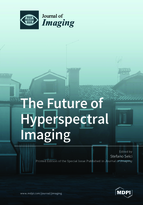The Future of Hyperspectral Imaging
A special issue of Journal of Imaging (ISSN 2313-433X).
Deadline for manuscript submissions: closed (26 October 2018) | Viewed by 103570
Special Issue Editor
Interests: scanning electron microscopy; optics; optoelectronics; experimental physics; solid state physics; condensed matter physics; optical physics; photonics; thin films and nanotechnology; nanotechnology
Special Issues, Collections and Topics in MDPI journals
Special Issue Information
Dear Colleagues,
Hyperspectral-based techniques (HSI) are pervading many, and increasing, fields of application. HSI began as a quite obvious tool within remote airborne observations; for instance, to determine land resources. The rapid development of spectroscopic hardware allowed fundamental passage of HSI from multispectral analyses (a few spectral lines), up to the full control and capture of spectral continuous ranges, while expanding its realm to food, biology, medicine, forensics, and art observation, just to name a few. The remarkable mix of the information (often represented as “hypercubes”) is at the same time spectroscopic (wavelength axis), structural (three axes), and plus time (a further axis). The structural part represents a range of information that can be within at least six orders of magnitude between micrometers (using HSI methods within microscopes, also of confocal type) and meters, while the usually-available large spectral range can be further functionally increased by adding fluorescence and Raman spectroscopies.
However, the rapid increase in the application areas will require a much higher speed in acquisition, clever data elaboration (e.g., neural networking methods are already used to safely assign local spectroscopic fingerprints to HIS images ), new hardware, and new ideas. There is a need to have effective tools, for instance, to make food analyses on real stocks, in real time and compatible with the daily products’ market, or make diagnoses on cells to reveal cancer during a routine medical check, without the need for a long wait.
Which advancements will be eventually more productive and innovative in this field?
We request contributions presenting techniques (methods, tools, ideas, or even market evaluations) that will contribute to the future roadmap of HSI, as well as concepts for significantly innovative objectives in HSI techniques. Scientifically founded innovative and speculative research lines are welcome for proposal and evaluation.
Dr. Stefano Selci
Guest Editor
Manuscript Submission Information
Manuscripts should be submitted online at www.mdpi.com by registering and logging in to this website. Once you are registered, click here to go to the submission form. Manuscripts can be submitted until the deadline. All submissions that pass pre-check are peer-reviewed. Accepted papers will be published continuously in the journal (as soon as accepted) and will be listed together on the special issue website. Research articles, review articles as well as short communications are invited. For planned papers, a title and short abstract (about 100 words) can be sent to the Editorial Office for announcement on this website.
Submitted manuscripts should not have been published previously, nor be under consideration for publication elsewhere (except conference proceedings papers). All manuscripts are thoroughly refereed through a single-blind peer-review process. A guide for authors and other relevant information for submission of manuscripts is available on the Instructions for Authors page. Journal of Imaging is an international peer-reviewed open access monthly journal published by MDPI.
Please visit the Instructions for Authors page before submitting a manuscript. The Article Processing Charge (APC) for publication in this open access journal is 1800 CHF (Swiss Francs). Submitted papers should be well formatted and use good English. Authors may use MDPI's English editing service prior to publication or during author revisions.
Keywords
- Hyperspectral imaging
- Real time imaging and spectroscopies
- Medical imaging by HSI
- HSI for biology
- Remote sensing
- Hyperspectral microscopy
- Fluorescence hyperspectral imaging
- Raman hyperspectral imaging
- Infrared hyperspectral imaging
- Nanoscale imaging in HSI
- Statistical methods for HSI
- Hyperspectral data mining and compression
- Hardware solutions for compact HSI instrumentation
- Hyperspectral market forecast







